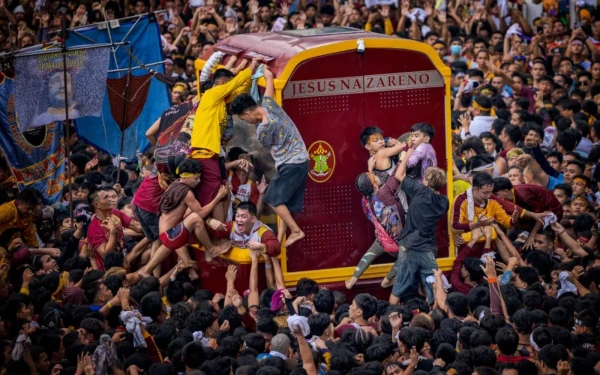The Black Nazarene procession in Manila, Philippines, which each year draws one of the world’s largest crowds for a religious devotion, attracted hundreds of thousands of enthusiastic pilgrims on January 9.
The procession, known locally as “Translation,” takes place every year in January and sees devotees carrying a life-size replica of a famous statue of Jesus carrying a black wooden cross throughout Manila. The Philippines and East Timor are the only countries in Asia with a Catholic majority, with more than 80% of the Philippine population declaring themselves Catholic.
Receive the main news from ACI Prensa by WhatsApp and Telegram
It is increasingly difficult to see Catholic news on social media. Subscribe to our free channels today:
The organizers of the procession estimated that about 220,000 people attended the Mass before the start of the procession, reported Rapplerand at least 800,000 people gathered at the church on Thursday night, according to Philippine Star. Hundreds of thousands more joined the procession as it passed.
As in previous years, many of the devotees were barefoot and some even jumped onto the float and clung to the cross carried by the famous statue.

Rappler interviewed to a 26-year-old British tourist in the procession, Adan Jeffrey, who said he was raised Catholic but now identifies as an atheist.
“I’ve never seen anything like it…the devotion they have to wait so long to kiss the statue is pretty phenomenal,” Jeffrey said.
“I have never felt as passionate about something as these people do about religion. So it’s amazing to see, it really opens my eyes.”
The Black Nazarene tradition was severely disrupted for several years by the COVID-19 pandemic; In 2020, 2021 and 2022, the procession was virtually completely cancelled. In 2023, approximately 103,277 faithful participated, much less than in previous years.
Last year’s procession, in January 2024, marked a return to the procession’s typical size and fervor after three years of drastic reduction. Also that year, the statue was placed in a display case for the first time and participants were prohibited from boarding the float as in previous years, although many ignored the directive, it reported at the time. UCA Newsan Asian Catholic news site.
The image of Jesus used in the procession is believed to have been brought from Mexico to the Philippine shores in 1606 by missionaries of the Order of the Augustinian Recollects. The life-size statue of Jesus is today enshrined in the famous minor basilica popularly known as the Quiapo Church, located in the Archdiocese of Manila. The image, which was first consecrated in the Church of San Juan Bautista in Luneta, was transferred to Quiapo in 1868.
The statue survived fires that destroyed the church twice, two earthquakes, floods caused by numerous typhoons, and bombings during World War II. The Quiapo church receives thousands of Catholics every day for Mass and confession.
Translated and adapted by the ACI Prensa team. Originally published in CNA.
